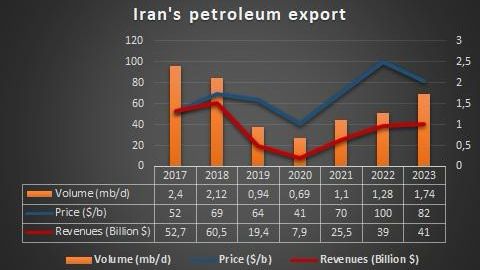Iran faces 26% oil revenue deficit despite surging exports

Iran’s Supreme Audit Court reports that despite a surge in oil exports, the projected revenues from these exports in recent months have not been met in the national budget.

Iran’s Supreme Audit Court reports that despite a surge in oil exports, the projected revenues from these exports in recent months have not been met in the national budget.
The report states that in the first five months of the current Iranian fiscal year (starting March 21), 26% of the projected oil export revenues remain unachieved. By comparison, during the same period last year, half of the budgeted oil export revenues had not been met. However, the Supreme Audit Court did not provide figures in US dollars, and it is not clear what the monetary figure of the shortfall is.
Iran's customs data indicates that in the first five months of the current fiscal year, the country exported $20 billion worth of oil and petroleum products, 45% of which should be allocated to the government budget.
The 26% shortfall in the share of oil revenues allocated to the government budget during the first five months of the current fiscal year persists despite both the volume of oil exports and global prices exceeding the projections in the national budget.
The budget bill for this year anticipated daily exports of 1.35 million barrels of oil and condensates. Furthermore, Iran also exports 240,000 barrels of fuel oil daily, bringing the total daily oil exports to 1.6 million barrels.
The budget also set the price of oil at €65 ($70) per barrel.
Tanker-tracking data reveals that Iran exported at least 1.85 million barrels per day of crude oil, condensates, and petroleum products (including fuel oil) during this period. Additionally, OPEC reports show that the average price of Iranian oil exceeded $80 per barrel. Given these figures, Iran should not only have avoided a shortfall in oil revenues allocated to the budget but should have exceeded its projected revenues by one-third.
The reason for this deficit is attributed to Iran's substantial expenses in bypassing US sanctions, including offering discounts to Chinese buyers.
Additionally, part of Iran’s fuel oil exports is bartered for gasoline, as Iran has faced a gasoline shortage for the past two years.
Data from Kpler, a commodity data company, also shows that during the first five months of the current fiscal year, 50,000 barrels per day of Iranian oil were sent to Syria, a country that has been receiving free oil from Iran for the past decade.
Previously, the government's budget share of oil export revenues was 45.5%. However, with the new government led by Masoud Pezeshkian and a request for help from the supreme leader Ali Khamenei to cover the budget deficit, it was decided recently that the National Development Fund's share of oil export revenues would be halved to 20%, while the government’s share would increase to 65.5%.
Additionally, 14.5% of oil revenues are allocated to the National Iranian Oil Company (NIOC).
Iran’s Oil Exports
According to the annual report of the Organization of the Petroleum Exporting Countries (OPEC), Iran’s oil export revenues reached about $72 billion after the 2015 nuclear deal (JCPOA). However, following the US withdrawal from the agreement, this figure fell below $8 billion in 2020.
With the election of Joe Biden as US president, Iran’s oil export revenues have increased annually, surpassing $41 billion in 2023, without considering oil discounts and the costs of circumventing sanctions.

However, Iran's customs statistics reported oil export revenues of $35.87 billion for the previous Iranian year, revealing that over $5 billion was lost in the process of bypassing sanctions. Additionally, Iranian customs reported that oil export revenues for the first half of the current fiscal year totaled just over $23 billion. Yet, given the export of 1.85 million barrels per day and an average price of $80 per barrel, revenues should have exceeded $27.5 billion during that period.
OPEC statistics show that the total volume of Iran's crude oil, condensates, and petroleum products exports last year averaged about 1.73 million barrels per day, which is two and a half times higher than when Joe Biden took office.
This figure, before US sanctions imposed in 2018, was around 2.5 million barrels per day.